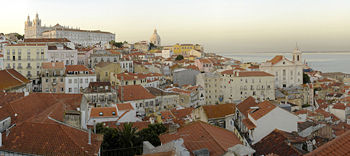
Alfama
Encyclopedia

Lisbon
Lisbon is the capital city and largest city of Portugal with a population of 545,245 within its administrative limits on a land area of . The urban area of Lisbon extends beyond the administrative city limits with a population of 3 million on an area of , making it the 9th most populous urban...
, spreading on the slope between the Castle of Lisbon and the Tejo
Tejo
Tejo can be:*The Tagus, a river on the Iberian Peninsula.*Tejo , a sport and national pastime of Colombia.*The Tutmonda Esperantista Junulara Organizo * Tejo, Ethiopia...
river. Its name comes from the Arabic
Arabic language
Arabic is a name applied to the descendants of the Classical Arabic language of the 6th century AD, used most prominently in the Quran, the Islamic Holy Book...
Al-hamma, meaning fountains or baths. It contains many important historical attractions, with many Fado
Fado
Fado is a music genre which can be traced to the 1820s in Portugal, but probably with much earlier origins. Fado historian and scholar, Rui Vieira Nery, states that "the only reliable information on the history of Fado was orally transmitted and goes back to the 1820s and 1830s at best...
bars and restaurants.
During the times of Moorish domination, Alfama constituted the whole of the city, which later spread to the West (Baixa neighbourhood). Alfama became inhabited by the fishermen and the poor, and its condition as the neighbourhood of the poor continues to this day. The great 1755 Lisbon Earthquake
1755 Lisbon earthquake
The 1755 Lisbon earthquake, also known as the Great Lisbon Earthquake, was a megathrust earthquake that took place on Saturday 1 November 1755, at around 9:40 in the morning. The earthquake was followed by fires and a tsunami, which almost totally destroyed Lisbon in the Kingdom of Portugal, and...
did not destroy the Alfama, which has remained a picturesque labyrinth of narrow streets and small squares. Lately the neighbourhood has been invigorated with the renovation of the old houses and new restaurants where Fado
Fado
Fado is a music genre which can be traced to the 1820s in Portugal, but probably with much earlier origins. Fado historian and scholar, Rui Vieira Nery, states that "the only reliable information on the history of Fado was orally transmitted and goes back to the 1820s and 1830s at best...
- Portuguese typical melancholy music - can be enjoyed.
Overlooking the Alfama is the mediaeval Castle of São Jorge, royal residence until the early 16th century and now offering the best views of the city. In the slopes of Alfama there are other terraces (miradouros) from which to see the city, like the Miradouro de Santa Luzia, near the church of the same name and over remnants of the Moorish city walls, and the Miradouro das Portas do Sol (Gates of the Sun). Near Miradouro of Santa Luzia is located the Museum of Decorative Arts (Museu de Artes Decorativas), a 17th century mansion with magnificent interiors.
Among the churches of the Alfama are Lisbon Cathedral
Lisbon Cathedral
The Patriarchal Cathedral of St. Mary Major is a Roman Catholic parish church located in Lisbon, Portugal. The oldest church in the city is the see of the Archdiocese of Lisbon. Since the beginning of the construction of the cathedral, in the year 1147, the building has been modified several...
(12th-14th centuries), the oldest of the city and located to the West of the neighbourhood, the Convent of the Grace (Convento da Graça, 18th century), near the Castle, the mannerist Monastery of São Vicente de Fora
Monastery of São Vicente de Fora
The Church or Monastery of São Vicente de Fora; meaning "Monastery of St. Vincent Outside the Walls" is a 17th century church and monastery in the city of Lisbon, in Portugal...
(late 16th-18th century), where the Kings of the House of Braganza
House of Braganza
The Most Serene House of Braganza , an important Portuguese noble family, ruled the Kingdom of Portugal and its colonial Empire, from 1640 to 1910...
are buried, and the baroque
Baroque
The Baroque is a period and the style that used exaggerated motion and clear, easily interpreted detail to produce drama, tension, exuberance, and grandeur in sculpture, painting, literature, dance, and music...
Church of Santa Engrácia
Church of Santa Engrácia
The Church of Santa Engrácia is a 17th century monument of the city of Lisbon, in Portugal. In the 20th century the church has been converted into the National Pantheon , in which important Portuguese personalities are buried...
(17th century), now converted into a National Pantheon for important Portuguese personalities.

